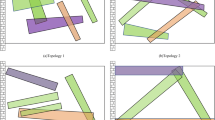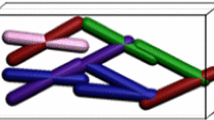Abstract
An efficient topology optimization method is developed newly in this study by combining the Non-uniform rational B-spline (NURBS) curves and moving morphable components (MMC). The MMC-based topology optimization is an explicit and geometrical method that utilizes a set of morphable components to create basic blocks for optimization. Optimum topologies may be obtained by optimizing shapes, lengths, thicknesses, orientations and layout of these components. The combined method adopts a different way in the creation of morphable components that consist of NURBS curves. Various kinds of complicated curved components can be built with NURBS curves or surfaces. Here, the NURBS curve is applied for shaping the geometries of structural basic components, and the coordinates of control points become design variables for topology optimization. A MATLAB optimization code has been developed. Four numerical examples of a short cantilever, a MBB beam, a simply supported beam with two point loadings, and a vehicle lower chassis structure subjected to crash loadings are provided to prove that the combined topology optimization approach coupled with NURBS curves and basic morphable components can get optimum topologies with clear topological boundaries successfully. As results of comparison study with other approaches, we can obtain the same topologies and faster convergence rates for the three separate cases. The combined approach can improve the smoothness of the topological boundaries that are similar to the shape optimization results obtained by post-optimization after the density-based topology optimization.





















Similar content being viewed by others
References
Bendsoe, M. P., & Kikuchi, N. (1988). Generating optimal topologies in structural design using a homogenization method. Computer Methods in Applied Mechanics and Engineering,71(2), 197–224.
Cazacu, R., & Grama, L. (2014). Overview of structural topology optimization methods for plane and solid structures. Annals of the University of Oradea, Fascicle of Management and Technological Engineering,23(3), 17–22.
Bendsoe, M. P. (1989). Optimal shape design as a material distribution problem. Structural Optimization,1(4), 193–202.
Bendsoe, M. P., & Sigmund, O. (2004). Topology optimization theory, methods and applications. Berlin: Springer.
Zhou, M., & Rozvany, G. I. N. (1991). The COC algorithm, Part II: Topological, geometrical and generalized shape optimization. Computer Methods in Applied Mechanics and Engineering,89(1), 309–336.
Rozvany, G. I. N., Zhou, M., & Birker, T. (1992). Generalized shape optimization without homogenization. Structural Optimization,4(3–4), 250–252.
Sigmund, O. (2001). A 99 line topology optimization code written in Matlab. Structural and Multidisciplinary Optimization,21(2), 120–127.
Andreassen, E., Clausen, A., Schevenels, M., Lazarov, B. S., & Sigmund, O. (2011). Efficient topology optimization in MATLAB using 88 lines of code. Structural and Multidisciplinary Optimization,43(1), 1–6.
Wei, P., Wang, M. Y., & Xing, X. (2010). A study on X-FEM in continuum structural optimization using a level set model. Computer-Aided Design,42(8), 708–719.
Wang, M. Y., Wang, X., & Guo, D. (2003). A level set method for structural topology optimization. Computer Methods in Applied Mechanics and Engineering,192(1–2), 227–246.
Allaire, G., Jouve, F., & Toader, A.-M. (2004). Structural optimization using sensitivity analysis and a level-set method. Journal of Computational Physics,194(1), 363–393.
Sigmund, O., & Maute, K. (2013). Topology optimization approaches. Structural and Multidisciplinary Optimization,48(6), 1031–1055.
van Dijk, N. P., Maute, K., Langelaar, M., & van Keulen, F. (2013). Level-set methods for structural topology optimization: A review. Structural and Multidisciplinary Optimization,48(3), 437–472.
Guo, X., Zhang, W., & Zhong, W. (2014). Doing topology optimization explicitly and geometrically: A new moving morphable components based framework. Journal of Applied Mechanics,81(8), 081009.
Zhang, W., Yuan, J., Zhang, J., & Guo, X. (2016). A new topology optimization approach based on moving morphable component (MMC) and ersatz material model. Structural and Multidisciplinary Optimization,53(6), 1243–1260.
Zhang, W., Zhang, J., & Guo, X. (2016). Lagrangian description based topology optimization: A revival of shape optimization. Journal of Applied Mechanics,83(4), 041010.
Guo, X., Zhang, W., Zhang, J., & Yuan, J. (2016). Explicit structural topology optimization based on moving morphable components (MMC) with curved skeletons. Computer Methods in Applied Mechanics and Engineering,310, 717–748.
Zhang, W., Li, D., Zhang, J., & Guo, X. (2016). Minimum length scale control in structural topology optimization based on moving morphable components (MMC) approach. Computer Methods in Applied Mechanics and Engineering,311, 327–355.
Zhang, W., Liu, Y., Wei, P., Zhu, Y., & Guo, X. (2017). Explicit control of structural complexity in topology optimization. Computer Methods in Applied Mechanics and Engineering,324, 149–169.
Zhang, W., Zhou, J., Zhu, Y., & Guo, X. (2017). Structural complexity control in topology optimization via moving morphable component (MMC) approach. Structural and Multidisciplinary Optimization,56(3), 535–552.
Zhang, W., Yang, W., Zhou, J., Li, D., & Guo, X. (2016). Structural topology optimization through explicit boundary evolution. Journal of Applied Mechanics,84(1), 01011.
Hou, W., Gai, Y., Zhu, X., Wang, X., Zhao, C., Xu, L., et al. (2017). Explicit isogeometric topology optimization using moving morphable components. Computer Methods in Applied Mechanics and Engineering,326, 694–712.
Hur, J., Kang, P., & Youn, S.-K. (2017). Topology optimization based on spline-based mesh-free method using topological derivatives. Journal of Mechanical Science and Technology,31(5), 2423–2431.
Costa, G., Montemurro, M., & Pailhes, J. (2017). On the integration of additive manufacturing constraints in the framework of a NURBS-based topology optimization method. In Proceedings of French mechanics congress (CFM), 2017. AFM.
Park, J., Goo, B., & Park, K. (2019). Topology optimization and additive manufacturing of customized sports item considering orthotropic anisotropy. International Journal of Precision Engineering and Manufacturing,20, 1443–1450.
Lee, K. (1999). Principles of CAD/CAM/CAE systems. USA: Addison Wesley Longman.
Svanberg, K. (1987). The method of moving asymptotes: A new method for structural optimization. International Journal for Numerical Methods in Engineering,24(2), 359–373.
Fukushima, J., Suzuki, K., & Kikuchi, N. (1992). Shape and topology optimization of a car body with multiple loading conditions. SAE technical paper 920777.
Author information
Authors and Affiliations
Corresponding author
Additional information
Publisher's Note
Springer Nature remains neutral with regard to jurisdictional claims in published maps and institutional affiliations.
Rights and permissions
About this article
Cite this article
Zheng, R., Kim, C. An Enhanced Topology Optimization Approach Based on the Combined MMC and NURBS-Curve Boundaries. Int. J. Precis. Eng. Manuf. 21, 1529–1538 (2020). https://doi.org/10.1007/s12541-020-00353-5
Received:
Revised:
Accepted:
Published:
Issue Date:
DOI: https://doi.org/10.1007/s12541-020-00353-5




